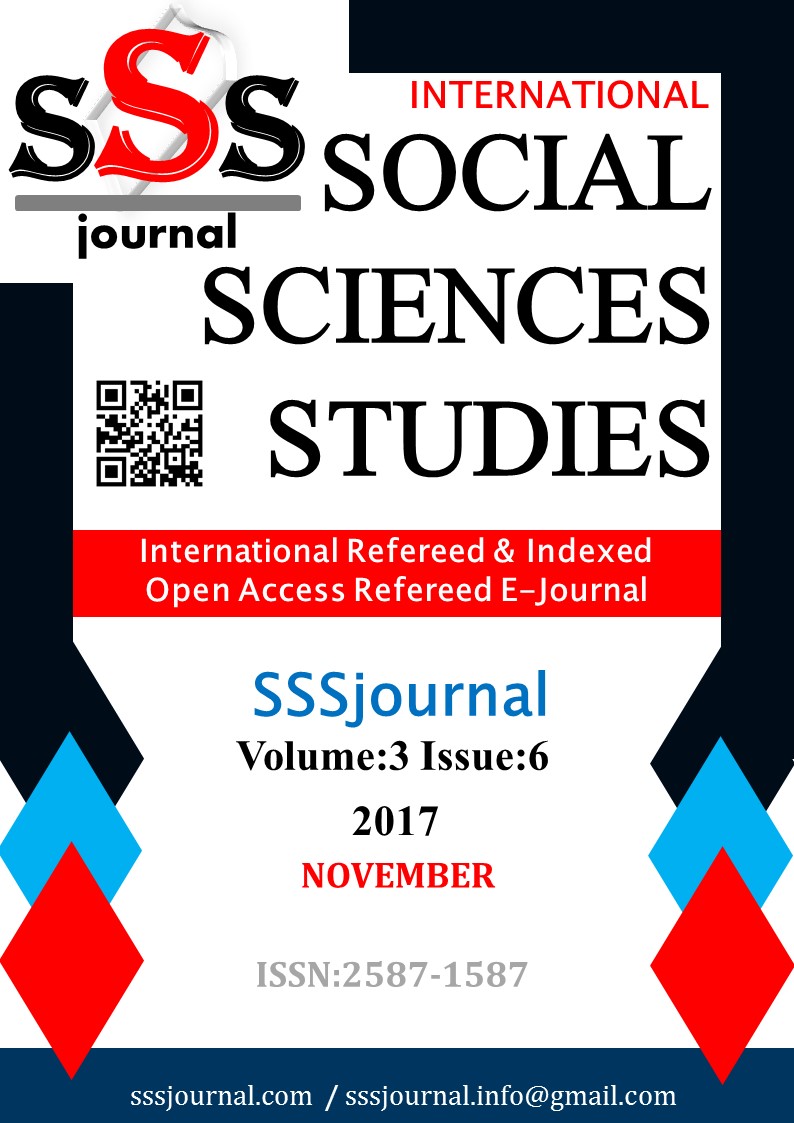Author :
Abstract
Bu çalışmada Türkiye’nin 2002-2016 dönemine ilişkin makroekonomik performansındaki değişim ve bu değişimin temel belirleyicileri Küresel Kriz baz alınmak suretiyle incelenmiştir. Bu nedenle dönem, Küresel Kriz öncesi (2002-2007) ve Küresel Kriz sonrası (2008-2016) olmak üzere iki alt döneme ayrılmıştır. Makroekonomik performans göstergeleri olarak büyüme oranı, enflasyon oranı, işsizlik oranı ve cari açık esas alınmıştır. Betimsel istatistiklerden yararlanılan çalışmada veriler Türkiye İstatistik Kurumu (TÜİK) veri tabanından elde edilmiştir. Çalışmadan elde edilen sonuçlara göre Küresel Kriz öncesi dönemde ekonomide büyüme ve fiyat istikrarı sağlanmıştır. Büyümenin temel belirleyicisi özel kesim tüketim harcamalarındaki artış, fiyat istikrarının temel belirleyicisi ise mali disiplin çerçevesinde yürütülen enflasyon hedeflemesi politikasına bağlılıktır. Küresel Kriz sonrası dönemde talepteki daralma Büyümeyi olumsuz yönde etkilerken, verimlilik artışı ve kamu harcamaları ise büyümeye olumlu etki eden belirleyici faktörler olmuştur. Küresel Kriz’in sebep olduğu dış kaynaklı maliyet arttırıcı gelişmeler bu dönemde fiyat istikrarını olumsuz yönde etkilemiştir. Küresel Kriz öncesi ve sonrası tüm dönem boyunca işsizlik ve cari açık sürekli ve yüksek oranlarda seyretmiştir. İşsizliğin temel belirleyicisi ekonomideki istihdam yaratmayan büyüme ve emek piyasasının yapısal sorunlarıdır. Cari açığın temel belirleyicisi ise ekonomide ithalata bağımlı bir büyüme ve yapısal sorunlardır. Çalışmadan elde edilen bir diğer sonuç ise ele alınan dört temel gösterge içinde Türkiye ekonomisinin en kırılgan taraflarının işsizlik ve cari açık sorunu olduğu şeklindedir.
Keywords
Abstract
This study investigates both the variation in Turkey’s macroeconomic performance over 2002-2016 and its causes. This period has been divided into two, pre-Global Crisis(2002-2007) and post-Global Crisis (2008-2016). In this study macroeconomic performance indicators that were chosen are growth rate, inflation rate, unemployment rate, and the current account deficit as a percentage of Gross Domestic Product (GDP). The study has been used descriptive statistics. The data used have been obtained from the database maintained by Turkish Statistical Institute (TÜİK). According to the findings of study, in the pre-Global Crisis period (2002-2007), growth of Turkish economy and stabilization of prices have been achieved. The basic reason for economic growth was the increase in private sector consumption expenditure. The stability of prices was based on the inflation targeting policy in the financial discipline. In the post-Global Crisis (2008-2016) period the diminishing demand affected economic growth negatively while productivity boost and the increase in public expenditure affected the economic growth positively. In this period cost increases in foreign markets have affected price stability negatively. The rate of unemployment and the current account deficit have remained both consistent and high in the two periods. Jobless growth and the problems of the labour market are the causes of the high rate of unemployment. Along with structural problems, growth that is dependent on imports have been the major reasons of the current account deficit. Another finding of this study is that the most fragile indicators are unemployment and current account deficit in these major macroeconomic indicators for Turkish economy.
Keywords
- Celasun, M. (2002). “2001 Krizi, Öncesi ve Sonrası: Makroekonomik ve Mali Bir Değerlendirme”,
- Celasun, M. (2002). “2001 Krizi, Öncesi ve Sonrası: Makroekonomik ve Mali Bir Değerlendirme”, http://content.csbs.utah.edu/~ehrbar/erc2002/pdf/i053.pdf (Erişim Tarihi: 22.07.2017).
- Efe, Ş. & Rumeli, M. (2002). Hükümet Performanslarının Değerlendirilmesi, Ankara Ticaret Yayınları, Ankara.
- Eğilmez, M. (2017). “Türkiye’de Bugün Yaşanan Enflasyonun Nedenleri”, http://t24.com.tr/ haber/mahfi-egilmez-yazdi-talep-mi-maliyet-mi-enflasyon-neden-artiyor-ne-yapmali,402718 (Erişim Tarihi 25.08.2017).
- Güney, A. (2009). “İşsizlik, Nedenleri, Sonuçları ve Mücadele Yöntemleri”, Kamu-İş Dergisi, 10(4):135-159, http://www.kamu-is.org.tr/pdf/1046.pdf (Erişim Tarihi: 18.08.2017).
- Kankılıç, N. (2016). “Kayıt Dışı Ekonomi (Sebepleri, Ölçüm Metotları, Boyutu ve Sonuçları”, (Mayıs), http://www.vmhk.org.tr/kayit-disi-ekonomi-sebepleri-olcum-metotlari-boyutu-ve-sonuclari/
- Sosyal Güvenlik Kurumu, SGK (2017). http://www.sgk.gov.tr/wps/portal/sgk/tr/calisan/kayitdisi_istihd am/kayitdisi_istihdam_oranlari/kayitdisi _ istihdam_orani
- Şiriner, İ. & Doğru, Y. (2005). “Türkiye Ekonomisi’nin Büyüme Dinamikleri Üzerine Bir Değerlendirme”, Yönetim Bilimleri Dergisi, 3(2): 162-182.
- Taban, S. (2011). Küresel Finans Krizi Öncesi ve Sonrası Dönemde Türkiye’de Ekonomik Büyümenin Dinamikleri, Seta Analiz Yayınları, İstanbul.
- T.C. Kalkınma Bakanlığı (2016). İşgücü Piyasasındaki Gelişmelerin Makro Analizi, Ankara.
- The Organisation for Economic Cooperation and Development, OECD, (1987). Economic Outlook, 41, Paris.The Organisation for Economic Cooperation and Development, OECD, (2016). Economic Surveys: Turkey. Paris.
- Türeli, R. A. (2008). “Türkiye Ekonomisinin Makroekonomik Dengelerinin Analizi (1990-2006)”. 2. Ulusal İktisat Kongresi, 20-22 Şubat 2008, DEÜ, 1-24, İzmir.
- Türkiye Cumhuriyeti Merkez Bankası, TCMB (2013). Enflasyon ve Fiyat İstikrarı, Ankara.
- Türkiye İstatistik Kurumu, TÜİK (2016). İşgücü İstatistikleri, (Mart), http://www.tuik.gov.tr/ PreHaberBultenleri.do?id=21577
- Türkiye İstatistik Kurumu, TÜİK (2017). İşgücü İstatistikleri, (Mayıs), S.24630, http://www.tuik. gov.tr/PreHaberBultenleri.do?id=24630
- Türkiye İstatistik Kurumu, TÜİK (2007). İşgücü, İstihdam ve İşsizlik İstatistikleri, Ankara. World Bank, WB (2017). Türkiye Düzenli Ekonomi Notu, (Şubat).
- Yıldız, T. & Yıldız, İ. (2017). “Suriyelilerin Türkiye Ekonomisinde Kayıt Dışı İstihdama Etkileri ve BununYansıması Olarak Türkiye’ye Maliyetleri Üzerine Bir İnceleme”, Journal of Economics Business and Political Researches, 2(3): 30-46.
- Yurdakul, F. ve Uçar, B. (2015). “The Relationship Between Current Deficit and Economic Growth: An Empirical Study on Turkey”, Procedia Economics and Finance, 26: 101-108.





